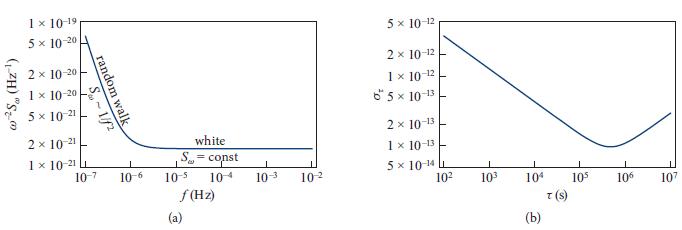Highly stable clocks (e.g., cesium clocks, hydrogen maser clocks, or quartz crystal oscillators) have angular frequencies
Question:
Highly stable clocks (e.g., cesium clocks, hydrogen maser clocks, or quartz crystal oscillators) have angular frequencies ω of ticking that tend to wander so much over very long timescales that their variances diverge. For example, a cesium clock has random-walk noise on very long timescales (low frequencies)
![]()
and correspondingly,

For this reason, clockmakers have introduced a special technique for quantifying the frequency fluctuations of their clocks. Using the phase

they define the quantity

where ω̅ is the mean frequency. Aside from the √2, this Фτ(t) is the fractional difference of clock readings for two successive intervals of duration τ . (In practice the measurement of t is made by a clock more accurate than the one being studied; or, if a more accurate clock is not available, by a clock or ensemble of clocks of the same type as is being studied.)
(a) Show that the spectral density of τ (t) is related to that of ω(t) by

(b) The Allan variance of the clock is defined as

Show that

where α is a constant of order unity that depends on the spectral shape of Sω(f) near f = 1/(2τ). Explain why, aside from the factor α, the right-hand side of Eq. (6.67) is the rms fractional fluctuation of ω at frequency 1/(2τ) in bandwidth 1/(2τ).
(c) Show that, if ω has a white-noise spectrum, then the clock stability is better for long averaging times than for short; if ω has a flicker-noise spectrum, then the clock stability is independent of averaging time; and if ω has a random-walk spectrum, then the clock stability is better for short averaging times than for long. (See Fig. 6.11.)
Fig. 6.11

Step by Step Answer:

Modern Classical Physics Optics Fluids Plasmas Elasticity Relativity And Statistical Physics
ISBN: 9780691159027
1st Edition
Authors: Kip S. Thorne, Roger D. Blandford





